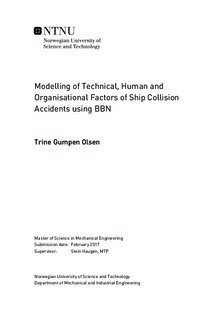| dc.description.abstract | Statistics show that 13-28% of all maritime vessel accidents are collisions, and the causes for these collisions are usually in the interface between the human, technical equipment and the organization. When adding that there are 7 to 53 causes per collision accident one can understand that this is a highly complex, socio-technical system. A suitable modelling tool for such complex systems is the Bayesian Belief Network, which graphically illustrates the relationships between various factors and a given critical outcome.
To quantitatively analyse the collision risk, which is important for deciding in which areas risk reduction is most beneficial, the various factors in the BBN need to be quantified. In this thesis there are identified numerous of measurable indicators to the various factors of a BBN collision model. These indicators are identified based on a literature review. A result of the review is that the vast majority of collision accidents are due to human factors and only a small percentage are caused by technical failure of equipment. Another result is that the implementation of new technology for reducing the collision risk may also have some negative consequences in terms of workload for the operators and user errors due to lack of knowledge. This shows that to reduce the collision risk further, the focus should be directed towards risk reducing measures for the human factors rather than the technical factors. | |

